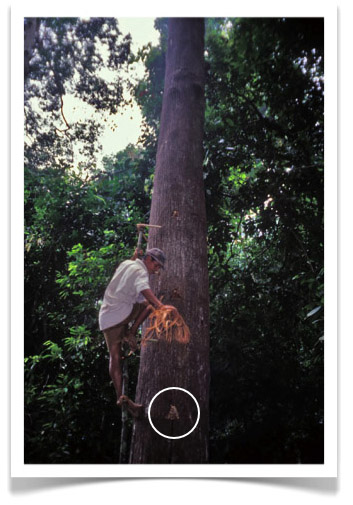Damar
 Tuesday, October 28, 2008 at 12:10PM
Tuesday, October 28, 2008 at 12:10PM 
Damar is the local name for the resin produced by several genera (e.g. Dipterocarpus, Shorea) of Dipterocarp trees in Southeast Asia. The dried resin (shown above) is a valuable source of varnish and caulking, and it is exploited commercially by numerous communities in Borneo and the Malay Peninsula.
 Damar is tapped by climbing the tree and cutting small pyramidal holes or "boxes" (indicated by the white circle above) at various heights along the trunk. In response to wounding, the tree starts to exude resin which collects in the bottom of the boxes. The damar is scraped out with a parang. The flow of damar usually stops after a couple of days because the resin ducts have become clogged with dried resin. To start the flow again, the old resin is melted away by building a small fire in each box. This method of tapping, not surprisingly, is known as "boxing and firing". [NOTE: The collector is about 10 - 12 m up the tree on a wobbly, disposable ladder made from bamboo].
Damar is tapped by climbing the tree and cutting small pyramidal holes or "boxes" (indicated by the white circle above) at various heights along the trunk. In response to wounding, the tree starts to exude resin which collects in the bottom of the boxes. The damar is scraped out with a parang. The flow of damar usually stops after a couple of days because the resin ducts have become clogged with dried resin. To start the flow again, the old resin is melted away by building a small fire in each box. This method of tapping, not surprisingly, is known as "boxing and firing". [NOTE: The collector is about 10 - 12 m up the tree on a wobbly, disposable ladder made from bamboo].


Reader Comments (2)
Found this information so interesting. I am an artist using encaustic wax as my medium. One ingredient of the paint is damar resin which I order, recieve in crystal form, melt and combine with beeswax. I didn't know much about it, other than how it effects the beeswax. I will continue to do research, but would like to know if I may reproduce your article and photos for our students. We have a school for the encaustic arts in Corralitos California. We average about 10-20 students a month.
Thanks for your consideration.
Wendy
www.waxworkswest.com
www.wendyaikin.com
You are more than welcome to use the text and photos from the damar post for your students. Glad you found it interesting and useful.